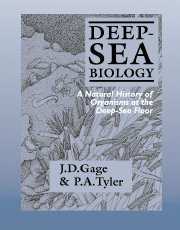Book contents
- Frontmatter
- Contents
- Preface
- Acknowledgements
- PART I The development of deep-sea biology, the physical environment and methods of study
- PART II Organisms of the deep-sea benthic boundary
- PART III Patterns in space
- PART IV Processes: patterns in time
- 11 Food resources, energetics and feeding strategies
- 12 Metabolic processes: microbial ecology, and organism and community respiration at the deep-sea bed
- 13 Reproduction, recruitment and growth of deep-sea organisms
- 14 Animal–sediment relations in the deep sea
- PART V Parallel systems and anthropogenic effects
- References
- Species index
- Subject index
12 - Metabolic processes: microbial ecology, and organism and community respiration at the deep-sea bed
Published online by Cambridge University Press: 05 June 2012
- Frontmatter
- Contents
- Preface
- Acknowledgements
- PART I The development of deep-sea biology, the physical environment and methods of study
- PART II Organisms of the deep-sea benthic boundary
- PART III Patterns in space
- PART IV Processes: patterns in time
- 11 Food resources, energetics and feeding strategies
- 12 Metabolic processes: microbial ecology, and organism and community respiration at the deep-sea bed
- 13 Reproduction, recruitment and growth of deep-sea organisms
- 14 Animal–sediment relations in the deep sea
- PART V Parallel systems and anthropogenic effects
- References
- Species index
- Subject index
Summary
MICROBIAL ECOLOGY: APPROACH AND PROBLEMS
The first observations of bacterial populations in the deep sea were made in 1882 and 1883 during the cruises of the ‘Travailleur’ and ‘Talisman’ (Certes, 1884). Although observations continued to be made, no data became available on rates of deep-sea bacterial metabolism until the early 1950s. Morita & Zobell (1955) and Zobell and Morita (1957) demonstrated that bacterial activity in deep-sea sediments was very low. This was not thought surprising as the low temperature, high pressure and low nutrient levels known to occur in the deep sea did not present a particularly favourable milieu for bacterial growth. All bacterial activity in the deep sea (with the exception of chemosynthesis which is limited to hydrothermal vents and sulphide-rich cold seeps – see Chapter 15) is heterotrophic, requiring an energy source in the form of organic matter ultimately derived from surface production.
In the last 20 years there has been a great effort in understanding the bacterial ecology of the deep sea. This effort was stimulated by two unrelated events. The first was the accidental sinking of the submersible ‘Alvin’. The submersible was swamped by a wave on launching. The crew escaped but left behind their lunch which consisted of bouillon, bologna sandwiches and apples. When ‘Alvin’ was recovered one year later, the scientists were amazed to find the food was still in good condition (see photograph in Jannasch, 1978) within the flooded pressure sphere, but it soon rotted even in a refrigerator at atmospheric pressure (Jannasch et al., 1970).
- Type
- Chapter
- Information
- Deep-Sea BiologyA Natural History of Organisms at the Deep-Sea Floor, pp. 283 - 300Publisher: Cambridge University PressPrint publication year: 1991

